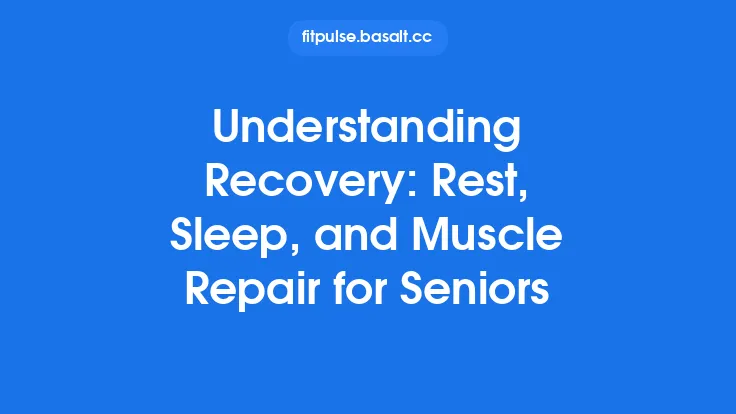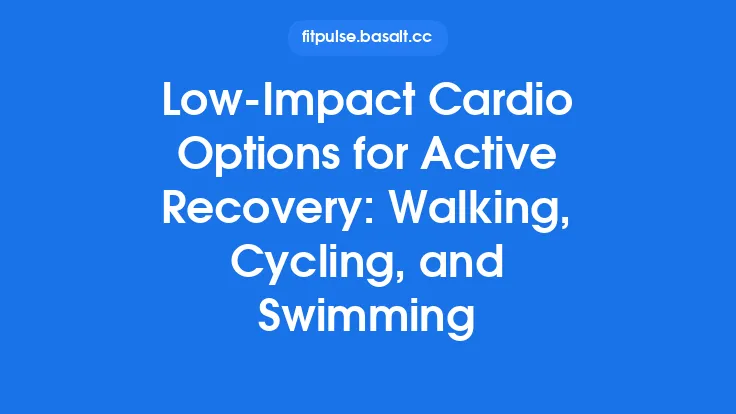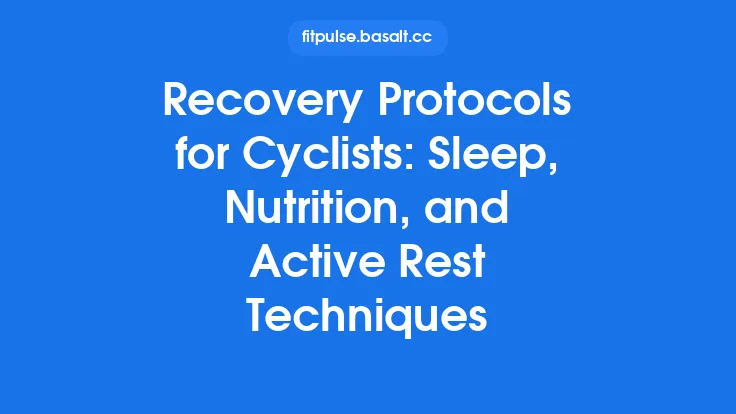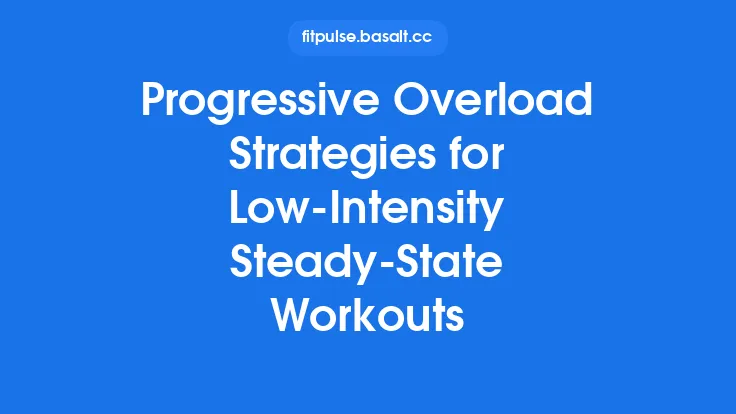Active recovery is often misunderstood as “doing nothing” or simply “taking a day off.” In reality, it is a purposeful, low‑intensity approach to movement that supports the body’s natural repair processes while still keeping the muscles, joints, and nervous system engaged. By deliberately dialing down the workload after a hard training session or competition, athletes can accelerate the removal of metabolic by‑products, promote tissue remodeling, and maintain a habit of consistent activity—all of which translate into faster gains over the long term.
What Makes a Workout “Active Recovery”?
Active recovery sits on a continuum between full‑intensity training and complete rest. The defining characteristics are:
| Parameter | Typical Range for Active Recovery | Why It Matters |
|---|---|---|
| Intensity | 30–60 % of maximal effort (often expressed as 2–3 on a 0–10 RPE scale) | Keeps circulation elevated without imposing additional stress on the same physiological systems that were heavily taxed. |
| Duration | 15–45 minutes per session, depending on the overall training load | Sufficient time to stimulate blood flow and metabolic clearance while avoiding fatigue accumulation. |
| Complexity | Simple, repetitive movement patterns (e.g., easy pedaling, gentle rowing, low‑intensity elliptical) | Reduces neuromuscular demand, allowing the central nervous system to recover. |
| Purpose | Facilitate recovery, maintain mobility, and preserve a habit of daily movement | Aligns with the broader goal of long‑term performance improvement. |
The key is intent: the session is designed to support recovery, not to elicit further adaptation.
The Physiology Behind Low‑Intensity Workouts
1. Enhanced Blood Flow and Metabolite Clearance
During high‑intensity exercise, muscles accumulate lactate, hydrogen ions, and other metabolites that contribute to fatigue and delayed‑onset muscle soreness (DOMS). Low‑intensity activity maintains an elevated cardiac output, which in turn:
- Increases capillary perfusion – delivering oxygen and nutrients to fatigued fibers.
- Accelerates lactate shuttling – moving lactate from active muscle cells into the bloodstream where it can be oxidized by the heart, liver, or less‑fatigued muscle groups.
- Facilitates removal of inflammatory mediators – reducing the magnitude of the inflammatory response that can impede recovery.
2. Neuromuscular Reset
High‑intensity bouts place a substantial demand on the central nervous system (CNS). An active recovery session provides a “reset” by:
- Lowering motor unit firing rates – allowing synaptic neurotransmitter stores to replenish.
- Re‑establishing proprioceptive feedback – gentle movement reinforces joint position sense without the overload that can cause micro‑damage.
3. Hormonal Modulation
Intense training spikes catabolic hormones (e.g., cortisol) and suppress anabolic signals (e.g., testosterone, IGF‑1). Low‑intensity work can:
- Moderately elevate growth hormone – which aids in tissue repair.
- Blunt cortisol spikes – by maintaining a calmer physiological state compared to complete inactivity, which can sometimes prolong stress hormone elevation.
4. Mitochondrial Maintenance
Even at low intensities, mitochondria are still being stimulated. This “maintenance dose” helps:
- Preserve oxidative capacity – ensuring that the energy systems remain primed for the next training stimulus.
- Promote mitochondrial biogenesis – especially when active recovery is consistently incorporated over weeks.
Evidence‑Based Benefits of Active Recovery
| Study | Population | Protocol | Main Finding |
|---|---|---|---|
| Bishop et al., 2010 | Competitive cyclists | 10‑min low‑intensity pedaling vs. passive rest after a 90‑min interval session | Active recovery reduced blood lactate by ~30 % and improved subsequent 5‑km time trial performance. |
| Miller & Sawka, 2015 | Collegiate sprinters | 20‑min light rowing after a sprint workout | Participants reported lower perceived soreness (RPE ↓ 1.5) and displayed faster peak power output 24 h later. |
| Kellmann et al., 2018 | Recreational weightlifters | 30‑min brisk walking on recovery days for 6 weeks | Significant improvements in muscle soreness scores and a modest increase in squat volume (+4 %). |
| Halson, 2021 (review) | Mixed sports | Meta‑analysis of active vs. passive recovery | Active recovery consistently yielded better short‑term performance (≤24 h) without compromising long‑term training adaptations. |
Collectively, the literature underscores that low‑intensity movement is not merely a “nice‑to‑have” but a scientifically supported tool for accelerating recovery and preserving performance.
Designing an Effective Active Recovery Session
While the article on “Designing an Effective Active Recovery Day” delves into detailed programming, the following high‑level framework can be applied universally:
- Select a Modality Aligned with Your Preferences
Choose an activity that you can sustain at a low effort level without mental fatigue. The goal is to keep the session enjoyable, which enhances adherence.
- Set a Target Intensity
Aim for a heart rate that is comfortably below the aerobic threshold (often 50–60 % of max). If you lack a heart‑rate monitor, use the “talk test”: you should be able to hold a conversation without gasping.
- Maintain a Steady Pace
Avoid sudden bursts or intervals. Consistency is key to promoting circulation without re‑stimulating the same stress pathways.
- Incorporate Light Mobility Work (Optional)
Gentle joint circles or range‑of‑motion drills can be added, provided they stay within the low‑intensity envelope and do not become a structured stretching routine.
- Cool Down with a Brief Stretch
A short, static stretch (15–30 seconds per major muscle group) can help lock in the increased tissue length achieved during the session.
Common Misconceptions
| Misconception | Reality |
|---|---|
| Active recovery is “just cardio.” | While many active recovery activities are aerobic, the primary purpose is recovery, not cardiovascular conditioning. The intensity is deliberately low. |
| If I feel a little sore, I should skip the session. | Mild soreness is normal; the low‑intensity stimulus actually helps alleviate it by enhancing blood flow. |
| More is better – the longer the session, the greater the benefit. | Excessive duration can become a secondary training stimulus, potentially adding fatigue. Stick to the 15–45 minute window. |
| Active recovery replaces the need for sleep or nutrition. | It is complementary. Adequate sleep, protein intake, and hydration remain foundational for recovery. |
| Only elite athletes need active recovery. | Anyone engaging in regular training can benefit, from weekend warriors to seasoned competitors. |
Practical Tips for Consistency
- Schedule It Like a Training Session
Block the same time slot each week (e.g., “Monday 7 am active recovery”) to build habit.
- Use Low‑Barrier Environments
A home treadmill set to a gentle incline, a backyard bike, or a simple indoor rowing machine can eliminate excuses related to travel or gym access.
- Track Subjective Feelings, Not Numbers
Keep a brief log of how you feel before and after the session (energy, soreness, mood). Over weeks, patterns will emerge that guide adjustments.
- Pair With Recovery‑Focused Nutrition
A modest protein‑carbohydrate snack (e.g., Greek yogurt with fruit) within 30 minutes post‑session can further support glycogen replenishment and muscle repair.
- Mind the Weather
In extreme heat or cold, adjust the intensity or duration to avoid additional physiological stress.
Integrating Active Recovery Into a Periodized Plan
Even without delving into the specifics of periodization, it is useful to understand where active recovery fits:
- Micro‑Cycles (Weekly)
Most training weeks include 1–2 active recovery days, typically placed after the most demanding sessions (e.g., after a heavy leg day or a long run).
- Mesocycles (4–6 Weeks)
As training load ramps up, the proportion of active recovery may increase slightly to counterbalance cumulative fatigue.
- Macro‑Cycles (Annual)
During transition or “off‑season” phases, active recovery can become the primary mode of movement, preserving baseline fitness while allowing full physiological reset.
Frequently Asked Questions
Q: Can I do strength work on an active recovery day?
A: Light, body‑weight movements that stay well below your usual training intensity can be acceptable, but they should not be structured as a typical strength session. The emphasis remains on movement, not load.
Q: How do I know if my active recovery is too intense?
A: If you notice a rise in perceived exertion (RPE > 4), difficulty speaking, or lingering fatigue the next day, you are likely exceeding the low‑intensity threshold.
Q: Is foam rolling considered active recovery?
A: Foam rolling is a manual therapy technique rather than a cardiovascular activity. While it can complement active recovery, it does not replace the systemic benefits of low‑intensity movement.
Q: Should I wear a heart‑rate monitor?
A: It can be helpful for beginners to ensure you stay within the target zone, but the “talk test” is a reliable, equipment‑free alternative.
Q: Does active recovery help with injury prevention?
A: By promoting circulation, reducing stiffness, and maintaining movement patterns, active recovery can lower the risk of overuse injuries that stem from chronic tightness or poor tissue health.
Bottom Line
Active recovery is a scientifically grounded, low‑intensity strategy that accelerates the body’s natural repair mechanisms while keeping you moving. By understanding its physiological underpinnings, applying evidence‑based guidelines, and integrating it consistently into your training routine, you can experience reduced soreness, faster performance rebounds, and ultimately, greater long‑term gains. Remember: the goal isn’t to push harder—it’s to move smarter.





